All products featured are independently chosen by us. However, SoundGuys may receive a commission on orders placed through its retail links. See our ethics statement.
Apple Music vs Spotify
March 21, 2025
When it comes to the best music streaming services, Apple Music and Spotify immediately come to mind—which isn’t surprising, considering they lead the competition regarding the number of paid subscribers. Sporting different features catering to specific users, it can be difficult to choose between the two. Let’s dig a little deeper into Apple Music vs Spotify to see which is the right music streaming service for you.
- March 21, 2025: We added information on the upcoming Spotify Music Pro subscription tier.
- July 19, 2024: We updated this article with the latest Spotify and Apple music information, including updated pricing, the number of songs on each platform, and information about Spotify Audiobooks.
Apple Music vs Spotify: Streaming quality
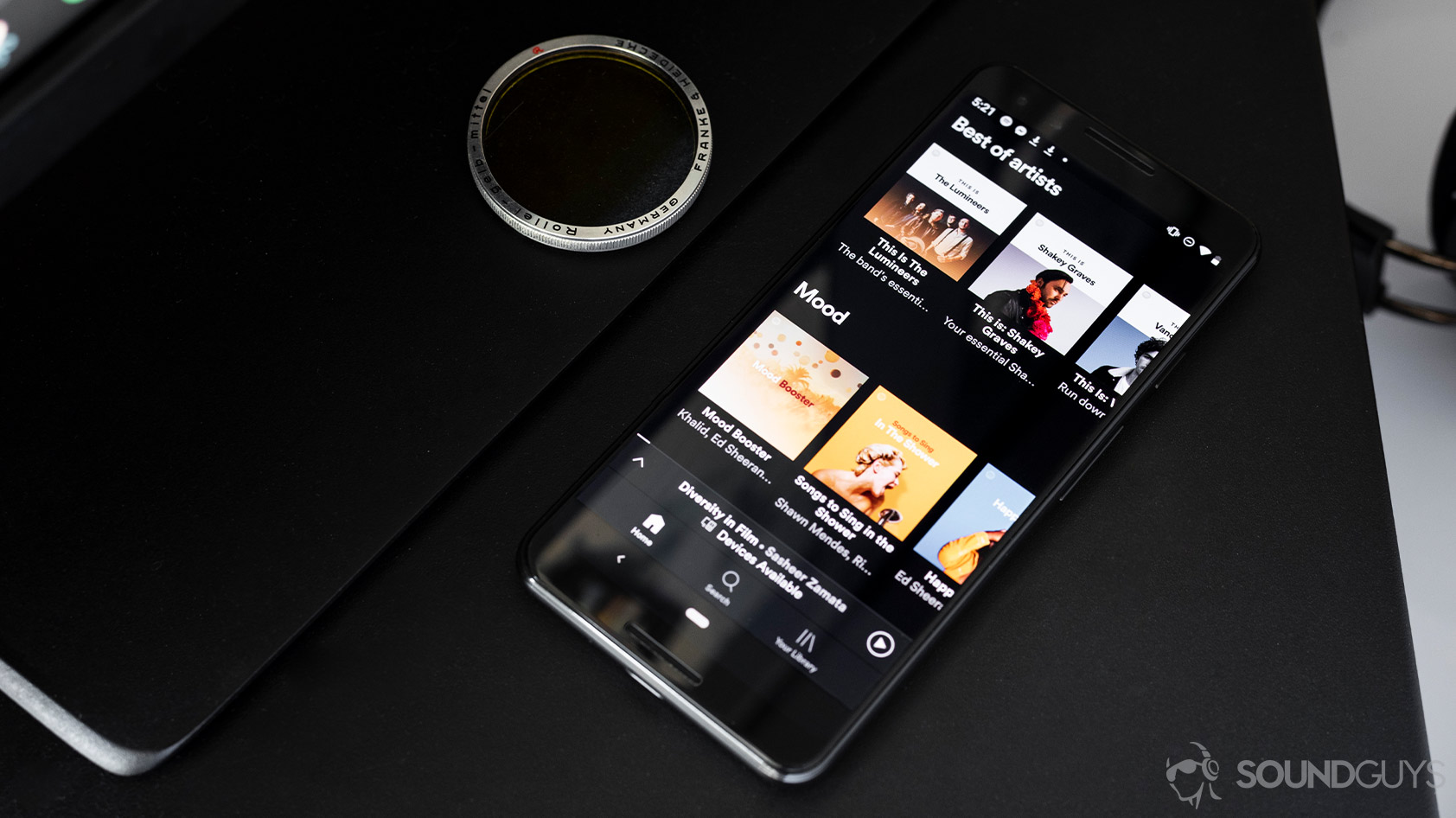
As of 2025, only Apple Music will provide you with an audiophile-grade streaming experience. Spotify announced its Spotify HiFi tier in February 2021 and said it would be released later that year. However, many years went by without anything materializing. Finally, we have some indication that Spotify Music Pro is coming soon, promising lossless audio, superfan perks, and DJ mixing for a higher cost, but we still don’t have a definitive release date.
Apple Music released its high-resolution streaming options at no extra cost. You can now stream 16-bit/44.1kHz, 24-bit/48kHz, and 24-bit/192kHz audio and use Spatial Audio with Dolby Atmos content through Apple Music. Apple Music also streams content at 256kbps and streams via one high-quality Bluetooth codec: AAC, which is far more efficient than most other open-source lossy alternatives. By default, Apple Music will stream at the highest possible quality and reduce quality when streaming using cellular data. However, this quality throttle can be disabled in the settings.
| Streaming Service | Max streaming quality | Supported Formats | Spatial audio option |
|---|---|---|---|
| Streaming Service Qobuz | Max streaming quality 24bit / 192kHz | Supported Formats AIFF, ALAC, FLAC, WAV, WMA Lossless | Spatial audio option No |
| Streaming Service Amazon Music Unlimited | Max streaming quality 24bit / 192kHz | Supported Formats FLAC, MP3 | Spatial audio option Yes |
| Streaming Service Tidal HiFi Plus | Max streaming quality 24bit / 192kHz | Supported Formats AAC, HiRes FLAC, FLAC | Spatial audio option Yes |
| Streaming Service Deezer HiFi | Max streaming quality 16bit / 44.1kHz | Supported Formats FLAC | Spatial audio option No |
| Streaming Service Spotify Premium | Max streaming quality 320kbps | Supported Formats AAC, Ogg Vorbis | Spatial audio option No |
| Streaming Service Apple Music | Max streaming quality 24bit / 192kHz | Supported Formats AAC, ALAC | Spatial audio option Yes |
| Streaming Service YouTube Music Premium | Max streaming quality 256kbps | Supported Formats AAC, OPUS | Spatial audio option No |
| Streaming Service SoundCloud Go+ | Max streaming quality 256kbps | Supported Formats AAC | Spatial audio option No |
| Streaming Service Slacker Radio | Max streaming quality 320kbps | Supported Formats MP3 | Spatial audio option No |
| Streaming Service Pandora | Max streaming quality 192kbps | Supported Formats AAC | Spatial audio option No |
| Streaming Service Spotify Free | Max streaming quality 160kbps | Supported Formats AAC | Spatial audio option No |
| Streaming Service Deezer Free | Max streaming quality 128kbps | Supported Formats MP3 | Spatial audio option No |
On the other hand, Spotify’s streaming quality is set to automatic by default, adjusting depending on your connection strength—whether you’re on Wi-Fi or cellular data. The app streams audio using the open-source Ogg Vorbis codec at up to 320kbps for Spotify Premium users and up to 160kbps for people with a free account.
The streaming quality from both services is sure to satisfy casual music listeners. However, if you’re someone who lives in an area with an unreliable internet connection, you’ll appreciate Spotify’s variable streaming quality options for an uninterrupted playback experience. If you don’t want to have to worry about altering stream quality to accommodate data constraints, Spotify also lets Premium users download and save up to 10,000 songs at a time on up to five different devices. Downloaded music can be saved at the same bitrate options as streaming—up to 320kbps.
Apple Music vs Spotify: Content and recommendations
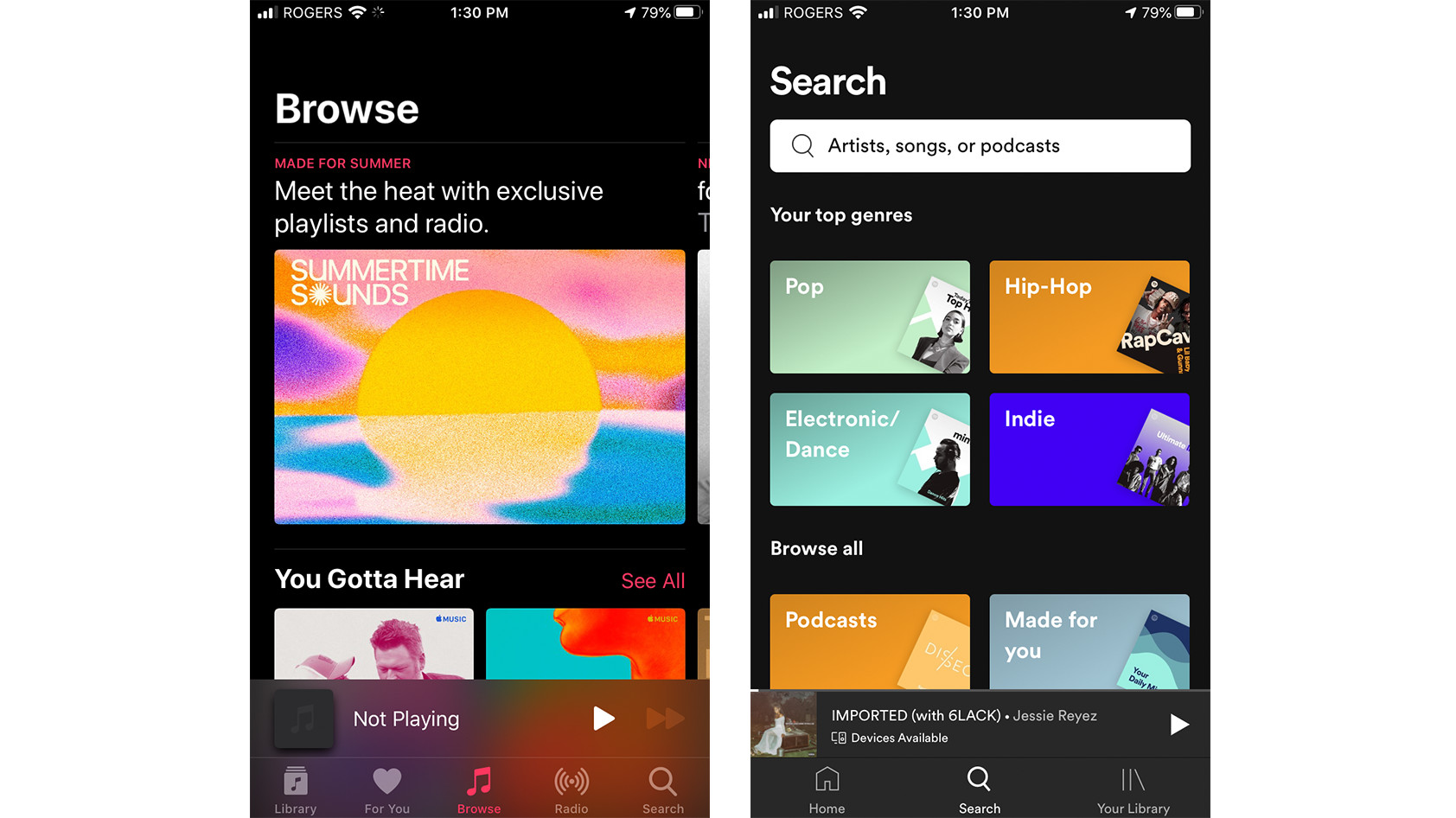
With over 100 million songs, you’ll be sure to find music from the artists you love and from artists you have yet to discover on Apple Music. Moreover, Apple Music is well-known for making exclusive deals with artists like Drake and Taylor Swift for early content releases. This exclusive content is due in large part to Apple’s paid-only service; users are required to have a paid subscription after the three-month free trial. On top of the exclusive content, users have access to many on-demand radio shows, including Apple Music 1.
While Apple Music used to have more content, Spotify’s music catalog now also has over 100 million songs, with around 40,000 added daily. Unlike Apple Music, Spotify also offers podcasts, with over 6 million titles currently on the platform. Over the years, Spotify has been diversifying its content library to become the ultimate audio streaming application, which is why the company has gone to great lengths to secure big-name podcasters like Joe Rogan. Spotify also now has audiobooks, with premium subscribers enjoying up to 15 hours of audiobook listening time each month. However, though you can’t listen to podcasts via Apple Music, Apple has a podcast service, Apple Podcasts, which is free for any Apple device owner.
There’s no beating Spotify when it comes to recommendations
Spotify is well-known by consumers for its ability to recommend songs based on your listening history. Sure, Apple Music’s human-curated Stations allow users to discover new music, though it doesn’t quite compare to the magic behind Spotify’s recommendation algorithms.
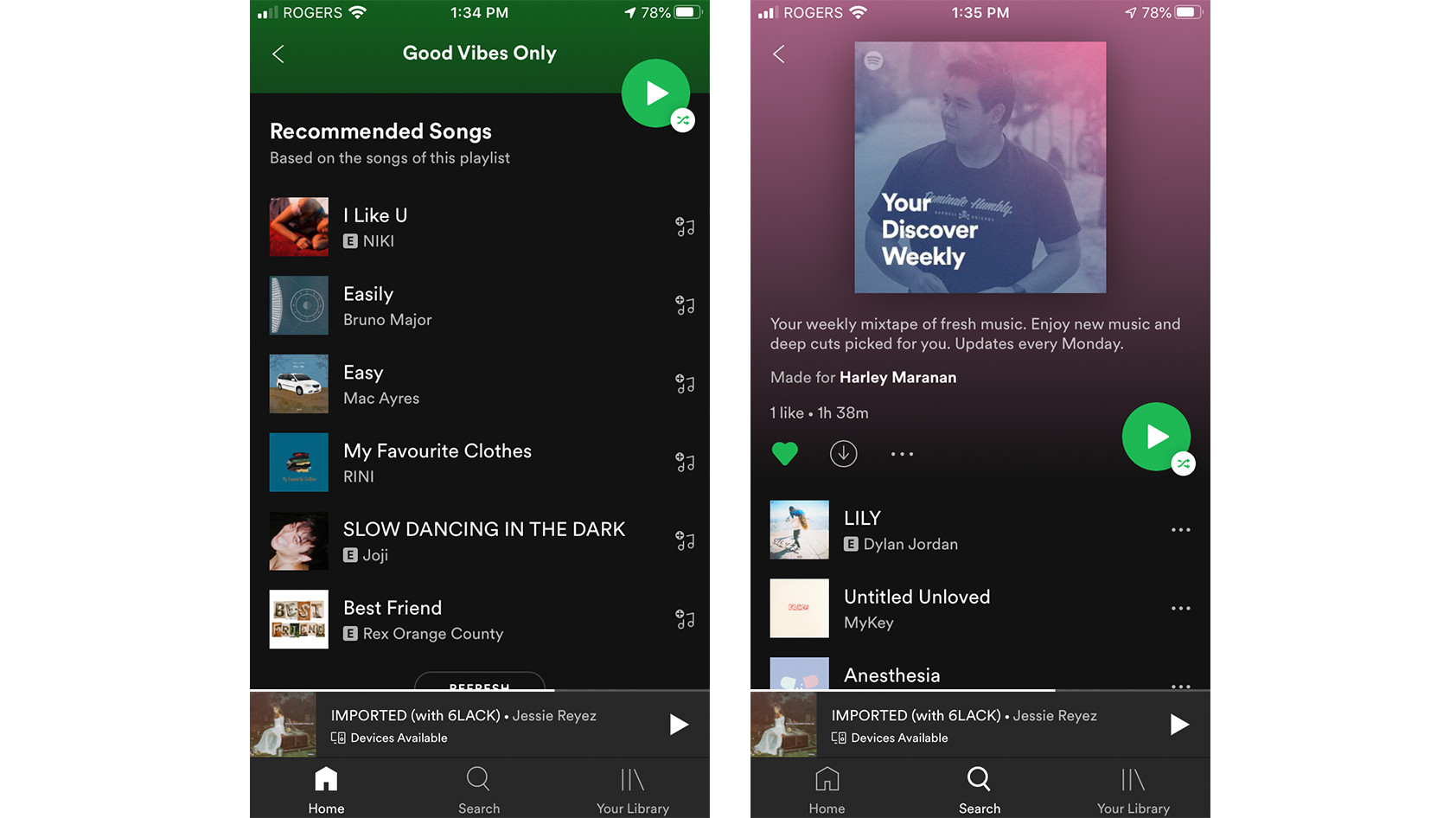
At the bottom of every playlist, you’ll see recommendations for new songs based on what’s on your list. You also get custom playlists such as Discover Weekly, which automatically generates hours’ worth of new music for you to discover based on your listening patterns. Spotify also includes a collection of hand-picked playlists featuring the latest hits, which are automatically reorganized for each user according to their tastes.
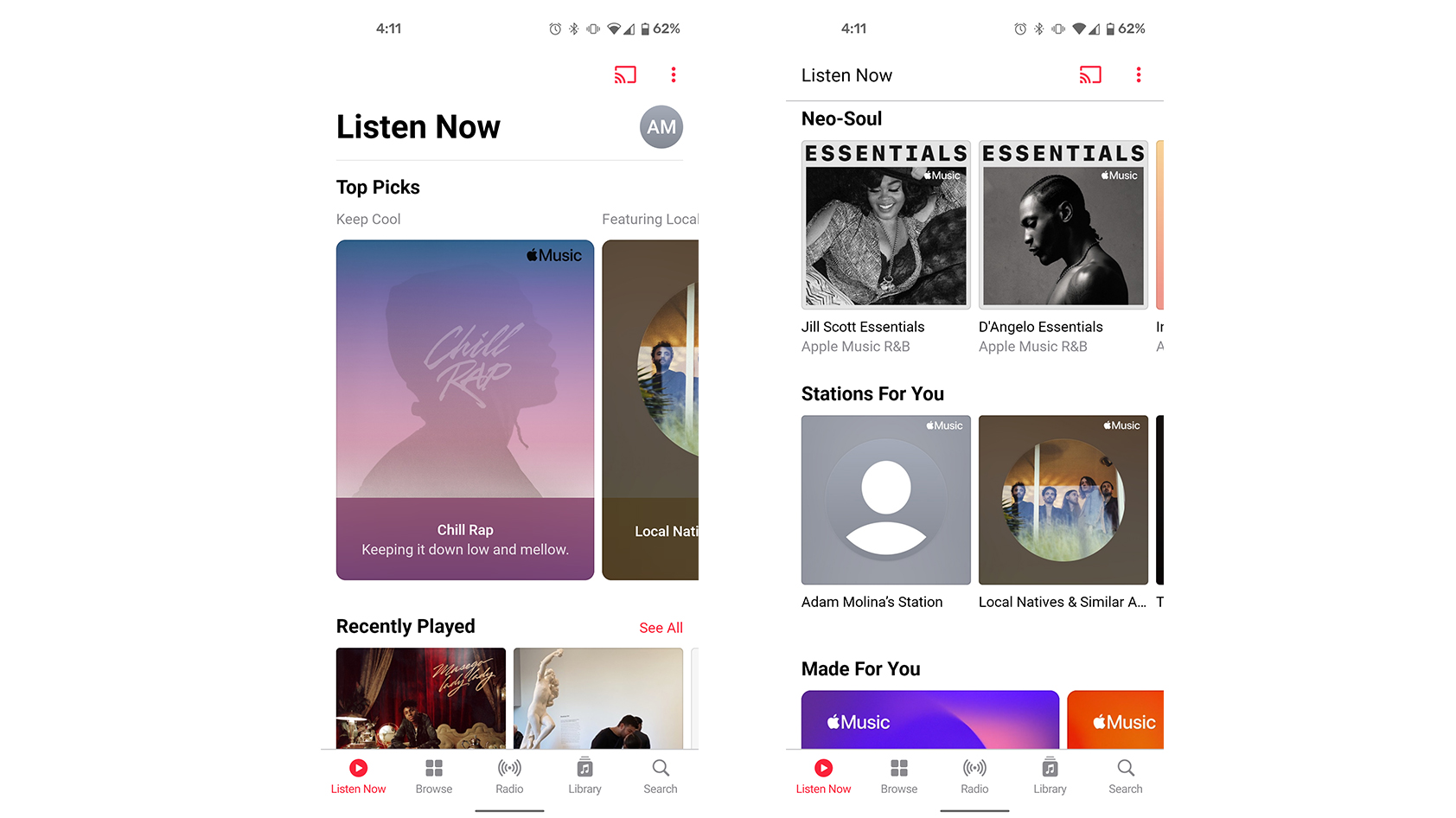
The latest version of Apple Music features a dedicated Home tab that offers song recommendations based on your listening habits. Home now replaces the cumbersome design of the old “For You” page with a much more streamlined interface that bears a strong resemblance to the Spotify app’s home page.
Alternatively, you can also take songs, albums, and playlists and create Stations, automatically generating a list of similar songs—including everything from hits to hidden musical gems. Spotify also has this feature, though most people opt to use the platform’s Discover Weekly playlist to find new music.
Does Apple Music or Spotify have better features?
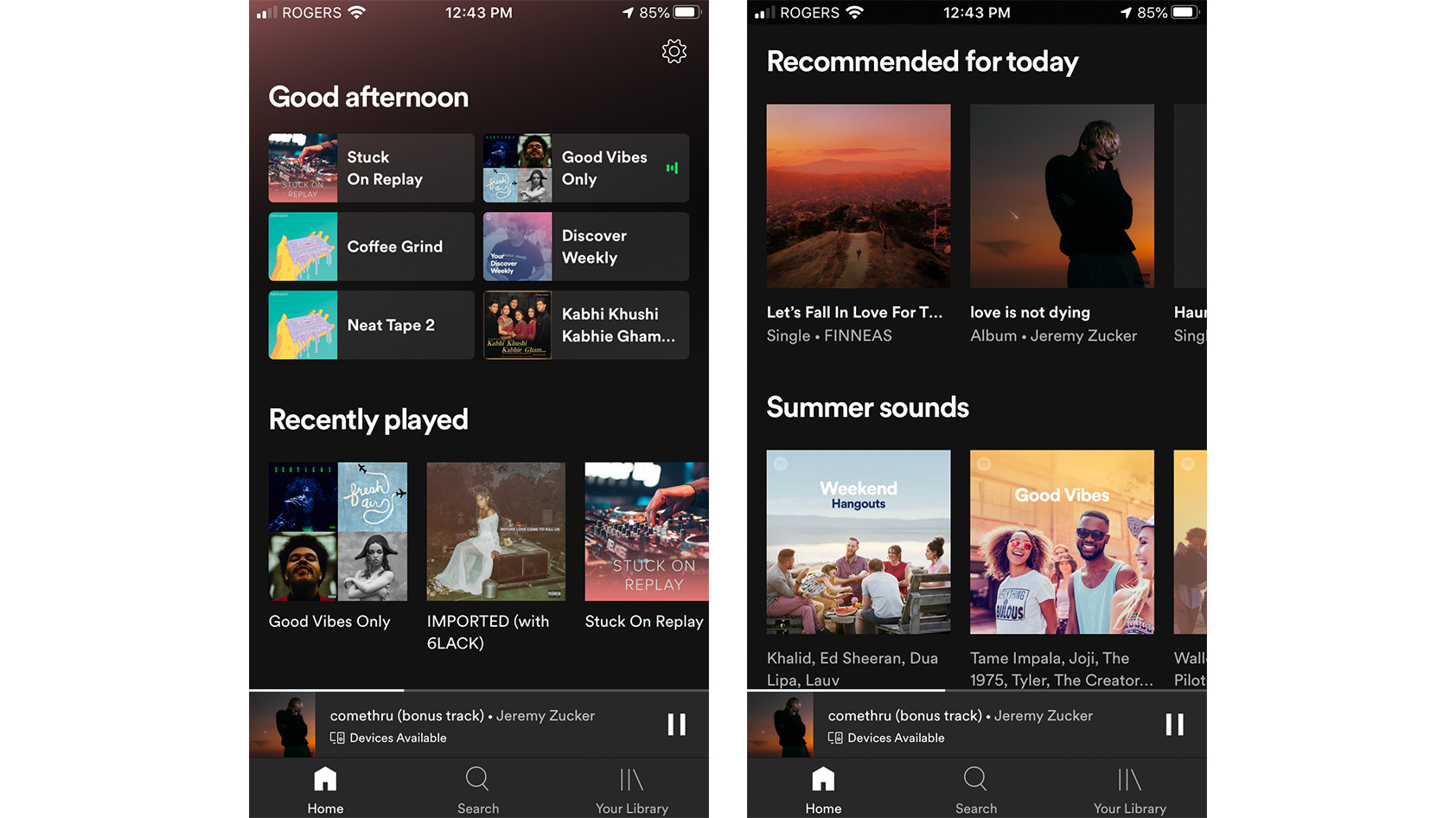
When it comes to music streaming apps, Spotify has the best user interface—which is surprising considering Apple is typically the king when it comes to design. In this case, Spotify’s app layout is much cleaner and better organized than Apple Music’s.
Spotify’s UI is laid out to give you instant access to your own content. The home page shows your recently played songs and playlists, which is what most people want to see when opening a music app. Every part of Spotify’s design puts your content at the forefront, only providing you with suggestions after you’ve seen what you want to see.
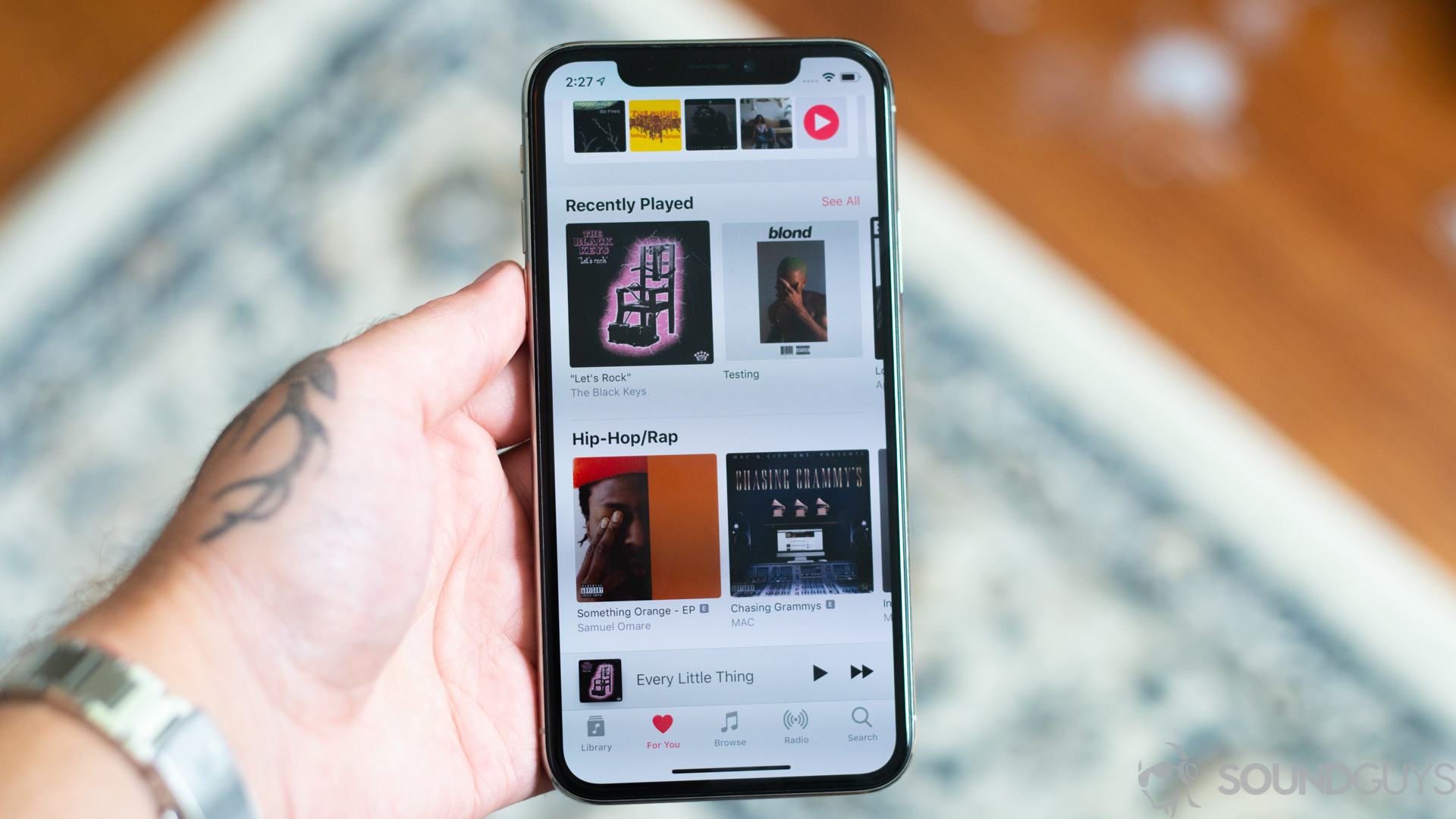
Apple Music is also well-designed, though it can come across as overwhelming with all the different tabs at the bottom of the screen. It seems like Apple wants to show off all the features at first glance, though this tends to get in the way of accessing your content. Apple Music’s interface divides its features into separate sections rather than integrating them into a single scrollable page like Spotify. The large, colorful artwork plays into Apple’s design aesthetics, making Apple Music—like the company’s other apps—quite pleasing to the eye.
Apple Music and Spotify are now tied for search functionality
In terms of search functionality, Apple Music outshone Spotify for quite some time because it had a Search by Lyrics feature, and Spotify didn’t. How many times have you wanted to listen to a song only to remember the lyrics and not the title? However, now Spotify has implemented this feature as well, so regardless of which service you’re using, you can forgo Googling and type your lyrics directly into the app’s search bar. You’ll then be presented with the song with a small excerpt showing the lyric you searched—talk about convenience.
Apple Music’s on-screen lyrics are a piece of eye candy
Both Apple Music and Spotify have on-screen, karaoke-style lyrics to their apps. Gone are the days when you’re jamming to your favorite song, only to forget the lyrics and switch into a freestyle mumble.
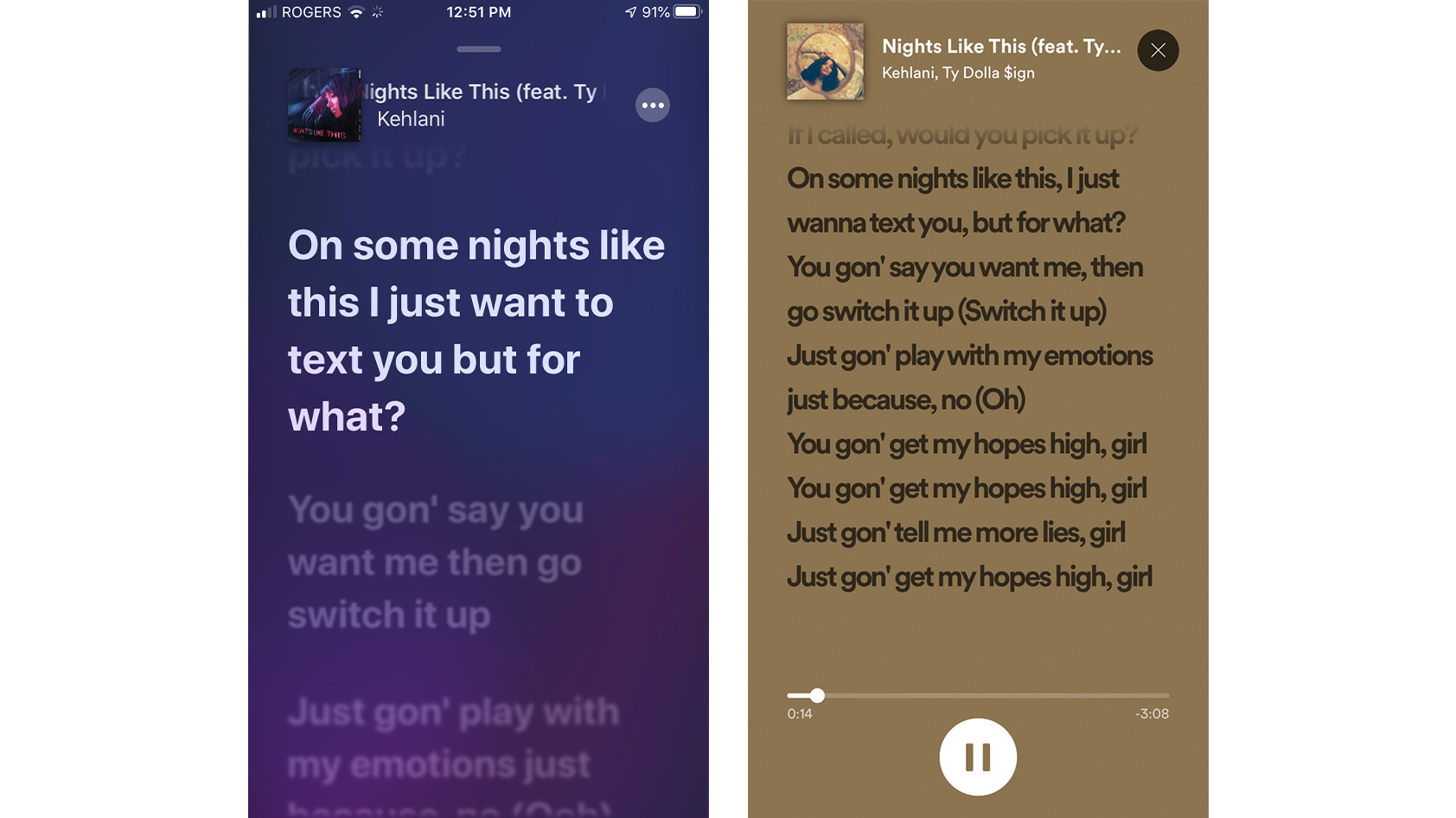
While Spotify’s on-screen lyrics are nicely integrated into the Now Playing screen, Apple Music’s full-screen presentation of the lyrics just seems more attractive with its bold text and pleasing Gaussian blur background—like a classier-looking karaoke machine. With both streaming services, the lyrics highlight as the singer sings them, and you have the option to scroll through the lyrics and jump to a specific line in a song.
Take control of your sound with EQ
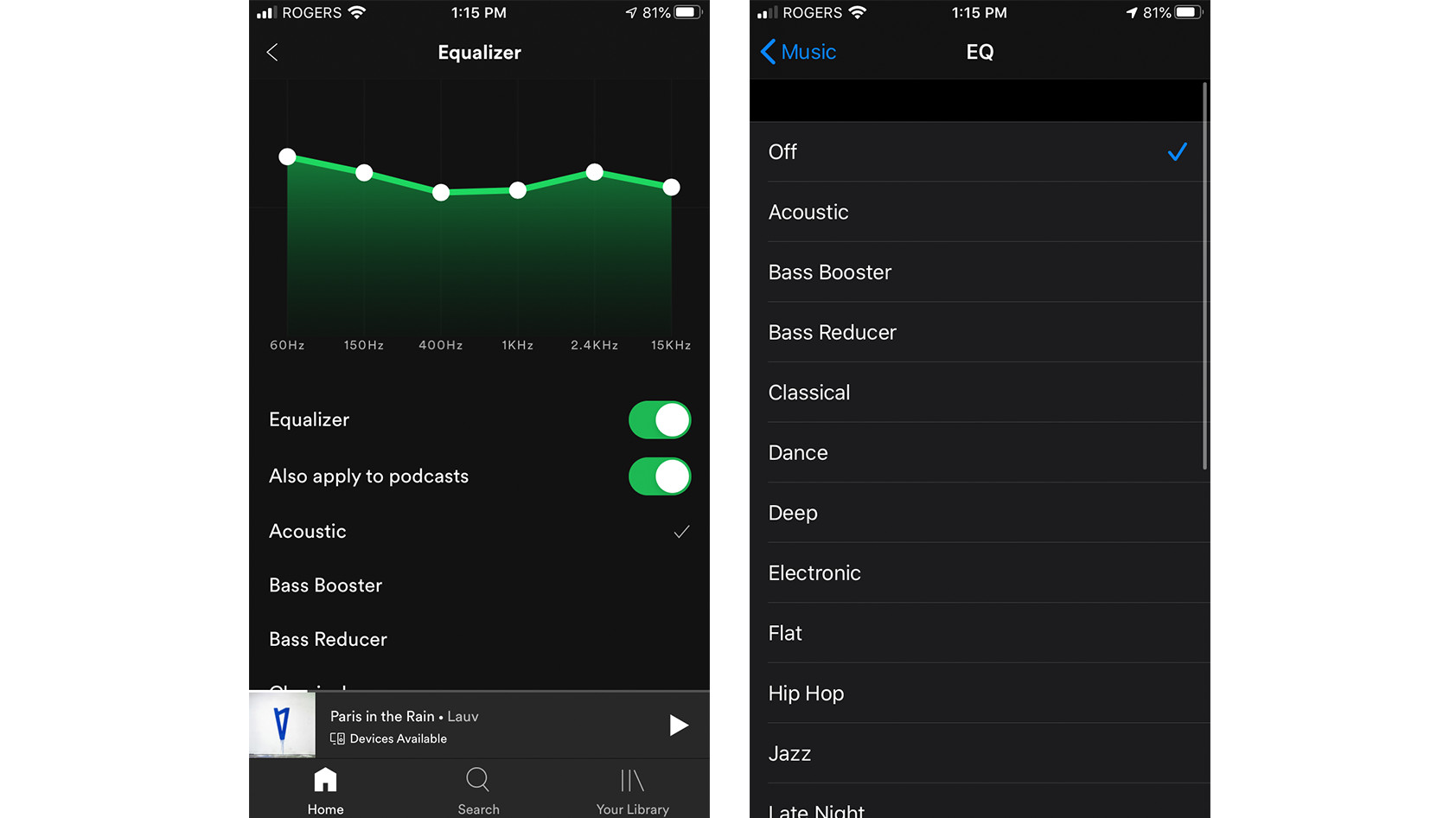
If you like to fine-tune your listening experience, you’ll enjoy Spotify’s inclusion of a graphical equalizer, allowing you to tailor the sound of your music to your tastes. The app also includes several EQ presets for you to choose from if you so desire. Android-owning Spotify users will be bumped into their phone’s system audio settings to EQ the sound, which may impact audio in other apps.
On the other hand, Apple Music doesn’t really offer any extensive EQ functionality. In fact, all you get is a list of EQ presets to choose from, which are only available to iOS users via the Settings app.
Spotify is better for use with voice assistants
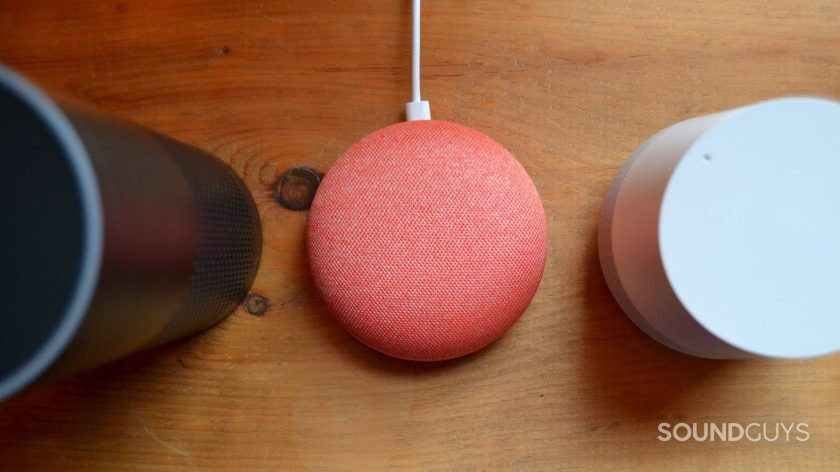
If you use a voice assistant in your daily life, whether it be through a smartphone or smart speaker, Spotify has you covered. The platform is supported by most, if not all, voice assistants—including Amazon Alexa, Google Assistant, and Apple’s Siri. Yes, you read that right. Even Siri supports Spotify. Do note that voice assistant integration requires a Spotify Premium subscription.
On the flip side, Apple Music is quite lacking in terms of voice assistant functionality, with only Siri having full support for the platform. Unless you’ve got a HomePod or any other Siri-enabled device, don’t expect to stream your Apple Music playlists using your non-Apple virtual assistant.
What is Apple Music Spatial Audio?
Spatial Audio with support for Dolby Atmos is available to Apple Music users. This is a feature that mimics the effects of surround sound and provides a 3D audio experience. Any Apple listening device, such as the Apple AirPods Max or an iPhone 12 Pro, will automatically play supported songs in the Dolby Atmos format. Spatial Audio with Dolby Atmos is available to any Apple Music subscriber at no additional cost. Compatible songs will be clearly labeled on the Apple Music interface, and Apple plans to create playlists of Dolby Atmos content to make it easy for users to find.
Apple Music vs Spotify: Sharing is caring
Both platforms make it easy to share music with your friends and family. With either app, you can share songs on your Instagram story or even send a direct link on your social media platform of choice. While this is certainly useful, Spotify has a couple of tricks up its sleeve that give it a leg up over Apple Music, to quickly share songs and playlists through Spotify Codes, which can be generated and scanned within the app itself.
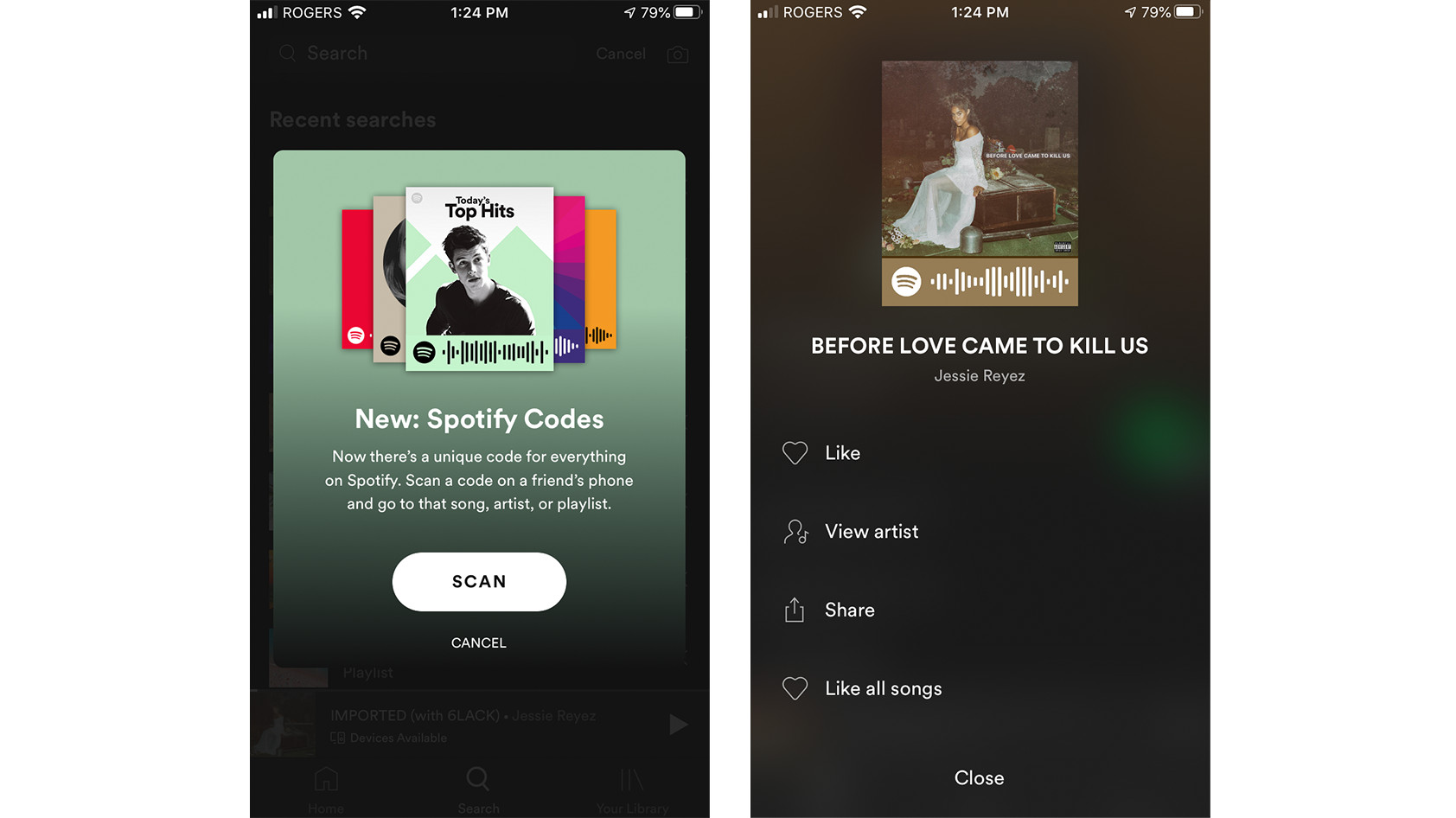
Originally, only Spotify allowed you to create Collaborative Playlists, allowing you and your friends to make the perfect playlist for a Friday night in, or a Saturday night out. However, Apple Music now also supports collaborative playlists.
Apple Music vs Spotify: Pricing
Apple Music is slightly cheaper than Spotify, but both have increased their prices in recent years. An individual Apple Music plan costs $10.99/month, less than Spotify Premium’s $11.99/month rate. For alternative plans, find the tables below:
| Apple Music Plan | Price | Features |
|---|---|---|
| Apple Music Plan Individual | Price $10.99/month | Features - Access to the Apple Music library and exclusive content - Offline listening - Ad-free streaming |
| Apple Music Plan Family | Price $16.99/month | Features - Access to the Apple Music library and exclusive content - Offline listening - Ad-free streaming - Access for up to six people - Personal accounts for each member |
| Apple Music Plan Student | Price $5.99/month | Features - Access to the Apple Music library and exclusive content - Offline listening - Ad-free streaming |
| Spotify Plan | Price | Features |
|---|---|---|
| Spotify Plan Free | Price $0 | Features - Music & podcast streaming with ads - 6 song skips per hour - Shuffle-only playback (except curated playlists) - Access to “Daily Mix” playlists - 30-day Premium trial available |
| Spotify Plan Individual (Premium) | Price $11.99/month | Features - Ad-free music & podcast streaming - Offline listening - Unlimited skips - On-demand playback - Up to 15 hours/month of audiobook listeninghours/month of audiobooks |
| Spotify Plan Duo (Premium) | Price $16.99/month | Features - All Individual features for 2 people - Separate accounts, Duo Mix playlist - Must share same address |
| Spotify Plan Family (Premium) | Price $19.99/month | Features - All Individual features for up to 6 accounts - Parental controls, Family Mix playlist - Spotify Kids app accesshours/month of audiobooks |
| Spotify Plan Student (Premium) | Price $5.99/month | Features - All Individual features - Includes Hulu (with ads) - Must verify student status |
Apple’s music streaming platform is available as part of Apple One, the company’s collection of services that gives you access to Apple TV+, Apple Arcade, and 50GB of iCloud storage. The Individual plan starts at $19.95/month, while a family plan is available for $25.95/month—with support for up to five users per family account.
Comparing the prices, it seems that both services offer great value for money, and you can’t go wrong either way. If you’re a student, Spotify may appeal more to you by including non-music streaming perks like Showtime and Hulu. However, if you’re already invested in the Apple ecosystem, then Apple Music—or even the Apple One bundle—may be worth considering.
Yes, you can try one month free on either Spotify or Apple Music.
How many users do Spotify and Apple Music have?
You probably want to have the same streaming platform as your friends and family. Everyone knows how annoying it is when a friend sends you an Apple Music link, and instead of just clicking it, you have to search for the song name on Spotify (or vice versa). So, which platform has more users? As of 2024, Spotify has over 600 million users, with over 200 million paid subscribers. Apple is less keen to share details about its number of subscribers, which leads us to believe it is much lower. The last time Apple confirmed its subscriber base was back in 2019 when they said Apple Music had 60 million global subscribers. That said, some reports have hinted that Apple Music has passed Spotify in US subscribers.
Apple Music vs Spotify: Which is better?
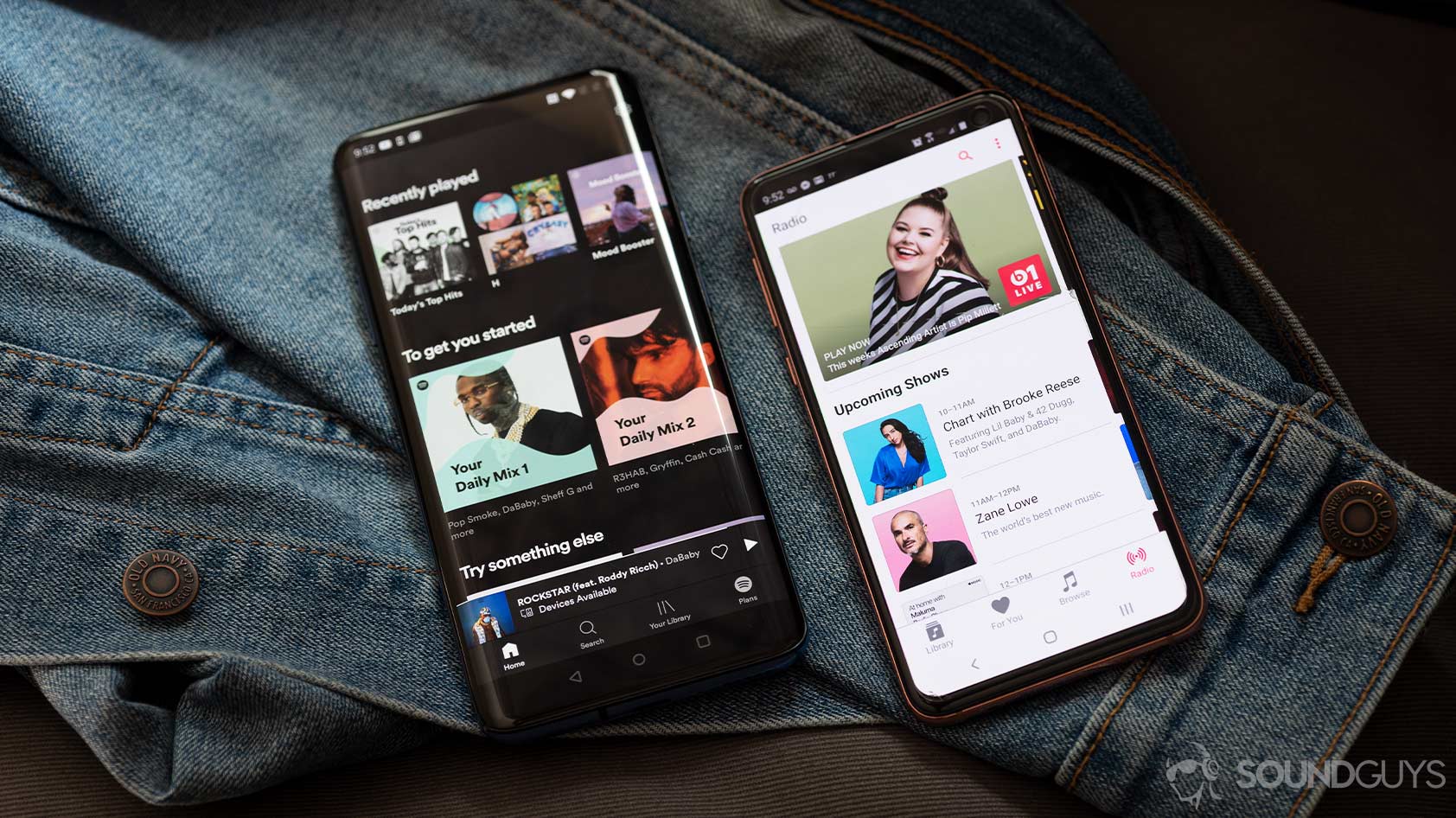
After comparing these two streaming services, it’s tough to declare a clear winner. Your choice should come down to what devices you use and which platform is more common in your social circles. If you and your family are entrenched in the Apple ecosystem, then you can’t go wrong with Apple Music. You’ll appreciate Apple Music’s familiar UI design language, Siri support, and automatic synchronization across Apple devices. Apple Music is also the better choice if you care about high-resolution streaming and Dolby Atmos support.
On the other hand, Spotify has always been designed with cross-compatibility in mind. If you’re looking to step out of Apple’s ecosystem when streaming music, Spotify is sure to satisfy listeners with its vast collection of music, podcasts, and audiobooks. Spotify has some other major advantages as well including its incredible music recommendation algorithm. We recommend you take advantage of the one-month free trial to test out both Spotify and Apple Music and then see which you prefer more.
Frequently asked questions about Apple Music and Spotify
You can use a service such as Soundiiz or Tune My Music to transfer your playlists from Apple Music to Spotify. Check out our article detailing how to transfer music from Apple Music to Spotify.
You can use a service such as Soundiiz or Tune My Music to transfer your playlists from Spotify to Apple Music. Take a look through our guide on how to transfer Spotify playlists to Apple Music.
No, the “download” function of Apple Music is not truly a download but rather a feature that allows you to listen to the music from the app offline. It is not the same as purchasing the music, and therefore, it can only be used with your Apple Music account.
Indeed you can! To add songs from your laptop/desktop, all you have to do is open your audio files using the Music app. After you’ve synchronized your library, your files will be available on all your devices that have Apple Music installed.
Yes; however, his process is far from intuitive. In order to add your own music from the Desktop app, go into your settings. Scroll to “Local Files” and enable “Show Local Files.” From there, you can specify paths for Spotify to find music from.